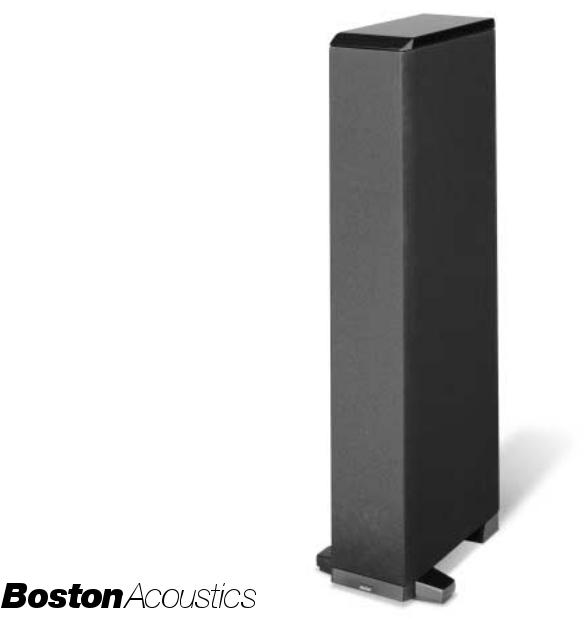Boston Acoustics VR950, VR940 User's Manual

VR940
VR950
Lynnfield VR™ Series
Specifications |
VR950 |
VR940 |
|
|
|
Frequency Response (±3dB) |
46–20,000Hz |
51–20,000Hz |
|
|
|
Recommended Amplifier Power |
15–150 watts |
15–125 watts |
|
|
|
Nominal Impedance |
8 ohms |
8 ohms |
|
|
|
Sensitivity [1 watt (2.83v) at 1m] |
89dB |
89dB |
|
|
|
Bass Unit |
Dual 51⁄4" (135mm) copolymer |
51⁄4 x 71⁄2" (135 x 191mm) copolymer |
Tweeter |
1" (25mm) anodized aluminum dome |
1" (25mm) anodized aluminum dome |
|
|
|
Crossover Frequency |
3100Hz |
3200Hz |
|
|
|
Dimensions (HxWxD) |
381⁄4 x 61⁄2 x 12" (972 x 165 x 305mm) |
341⁄2 x 61⁄2 x 93⁄4" (870 x 165 x 248mm) |
Front Foot Width |
101⁄2" (267mm) |
93⁄4" (248mm) |
Weight |
37 lbs (17kg) |
34 lbs (16kg) |
|
|
|
Finish |
Charcoal gray cloth with gloss black top |
Charcoal gray cloth with gloss black top |
|
|
|
Description
The VR940 and VR950 are compact floorstanding speaker systems that deliver the kind of powerful, impressive sound usually found only in much larger, more expensive speakers.
Their long-excursion bass units feature copolymer cones, butyl rubber surrounds, and a computer-optimized magnet structure for powerful bass and smooth, accurate midrange reproduction. A 1-inch (25mm) anodized aluminum Lynnfield VR tweeter, with our exclusive Amplitude Modification Device™ (AMD), produces extended, sparkling high frequencies.
The cabinets are constructed of Medium Density Fiberboard (MDF), chosen for its favorable acoustic characteristics, and have extensive internal bracing. The result is superb structural integrity that eliminates the spurious resonances and vibration that degrade the sound of ordinary speakers.
MagnaGuard® magnetic shielding ensures the speaker’s magnetic field does not interfere with the television’s picture, allowing placement next to a TV in a home theater system.
How to Connect Your Speakers
Correctly wiring your speakers is important for achieving the best sound quality. Wiring should take just a few minutes, but it’s important to do it carefully, since incorrect wiring (such as reversed connections) can result in a poor soundstage and poor bass.
We recommend 18-gauge wire or thicker for runs up to 25 feet (8m) and 16-gauge wire or thicker for longer runs. Separate the first few inches of the wire conductors. Strip off 1⁄2-inch (12mm) of insulation from the ends of each speaker wire to expose the two conductors and tightly twist the wire strands.
WARNING: To prevent electrical shock hazard, always switch off the amplifier or receiver when making connections to the speaker.
When making all connections, be sure to connect the + (red) on the speaker to the + (red) on the amplifier and the
– (black) on the speaker to the – (black) on the amplifier.
2
